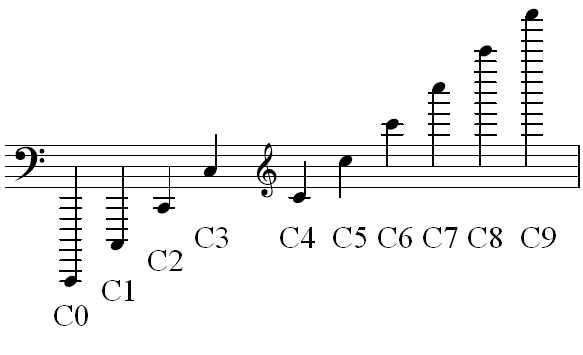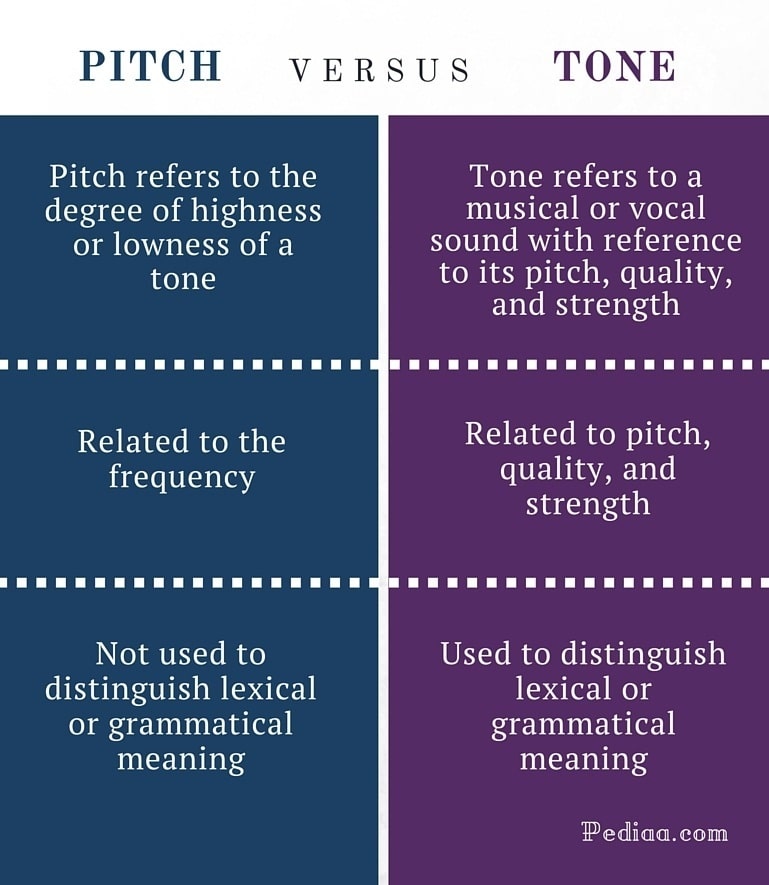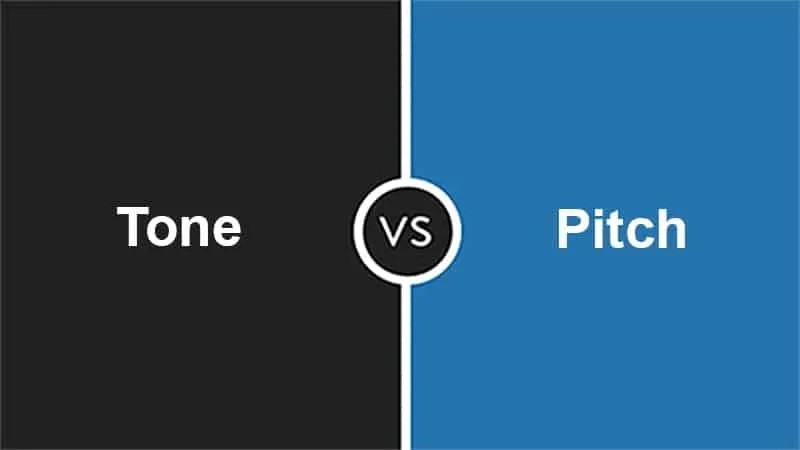Contents
Are you also curious about the difference between pitch and tone in Music and beyond? Or is there any to begin with? People, even those who have established themselves in the music industry, sometimes get confused as they use these words interchangeably. Read this article to be able to distinguish pitch from tone and use them in the right context.
What is Pitch?
It’s defined as the highness or lowness (in frequency) of a sound.
Let’s have a quick look at the meaning of ‘frequency’. Frequency is the number of vibrations per second.
This means that, in singing, when your vocal cords vibrate at a faster speed (high frequency), you have a high pitch. On the other hand, when your vocal cords vibrate slowly (low frequency), you’ll get a lower pitch. It should be perfect, as imbalances in pitch can easily be pointed out.

When it comes to speaking, some people speak naturally with higher pitch than normal, while others with a naturally low pitch voice. Females often have tiny or high. Males, on the other hand, generally have a low-pitched voice.
To put things into perspective, the pitch is a major attribute of a sound. Yet, the human auditory system is not capable of distinguishing frequency differences in certain situations. Why? Perceived pitch may vary depending on how far or near the listener is from the source of the sound. Hence, pitch is rather ambiguous since it’s subjective and the frequency is objective. Therefore, the frequency you hear (the pitch) might not be the actual frequency.
What is Tone?
Tone, on the other hand, refers to the quality of the sound. Some defined it as the color or timbre of a sound depending on the pitch, intensity, and strength of the sound. The tone of a sound can be described as warm, dark, bright, weak, full, raspy, rich, shrill, etc.
Two instruments with the same pitch may not have different tones. For example, the flute and the violin may have the same pitch, but they will have different tones.

Moreover, like pitch, tone is also very essential in daily conversations, not just in music. With a certain message delivered in the right tone, it’ll have an emotional impact on the listener. In other words, your tone is a very powerful tool to either connect or disconnect yourself with your listener. People’s emotions can be easily detected based on the tone of his/her voice.
What’s the Real Difference?
Let have a closer look at these two musical terminologies – how they differ – in the table below. Pitch and tone is compared in terms of quick definition, related elements, and lexical and grammatical meaning, respectively.

In addition to the table, here are a few more things to help you fully understand the difference between these two.
- In music, pitch can be perceived as the actual value of a tone, while the tone is more on the thickness (thinness) of the note.
- From the table, you can see that grammatical or lexical meaning isn’t applicable in pitch, only in tone. What does this mean? It’s primarily related to the emotional aspect of the sound. It’s the tone that conveys the overall emotion, hence it should be dependent on grammatical errors and lexical.
- Pitch needs to be perfect, while tone doesn’t need to. A slight change in the pitch (or wrong pitch) can change the tune of the song, which might not be pleasant to hear. Changes in the tone, on the other hand, aren’t that noticeable. If they are recognized, they aren’t regarded as flaws, rather some sort of improvisation of the song/music.
So, In Application…
Now that you are aware of the difference between tone and tone, it is now very clear to you the terms tone-deaf and high note. They are used very frequently by singers and music enthusiasts.
Tone Deaf or Pitch Deaf?
The definition of tone-deaf, amusia, is the inability of a person to recognize musical pitch. They can hardly differentiate two different notes, hence they produce pitch differently. From the definition itself, shouldn’t it be called pitch deaf?

Tone-deafness isn’t very common for singers and musicians. However, since it can be caused by brain injury, or it may occur naturally, a very small percentage of singers can be tone-deaf. This kind of disorder can be easily cured. Actually, those who aren’t exposed to music are the ones that have higher tendencies of experiencing tone-deafness.
High Note or High Pitch?
“I’m afraid I can’t hit high notes!” Just an FYI. Notes refer to the location of the pitch (it’s a named pitch) – high notes refer to high-frequency pitch, and low notes, otherwise. With this, is it safe to say high pitch, instead of high note?
Anyway, sometimes, these two terms also make singers and musicians, especially beginners, get confused. Having read this article, is there a difference in the way you perceive those words now as before?
Conclusion
Pitch and tone are music attributes that differ from each other. Pitch refers to the frequency of the sound (or voice) – high pitch (high frequency) and low pitch (low frequency). Tone, on the other hand, refers to the color or timbre of the sound. In other words, pitch is influenced by frequency, while tone by the quality of the sound.
While both may convey emotion, it’s the tone that really depicts the overall emotion of the sound. You can say that the sound is rich, full, bright, warm, raspy, etc., based on its tone. So, we like the sound or the song because the tone helps us feel the music and become connected to it. The quality of the song/music you’re listening to depends on the tone, which is also being influenced by the pitch of the voice.
The next time you use the terms pitch and tone, you shouldn’t interchange them. Actually, even if you may still have interchanged these two, no one will actually correct you. Since these terms have been mixed up even by professionals, it’s not a big deal. At least, you know the REAL difference between pitch and tone.

Hi music fan! I am Jeff. Hope that you enjoy some stuff I shared here in my personal blog.
About myself, Currently I am in charging as Artist Manager/Music Supervisor at 72 Music Management. I did managed album to Grammy Award in 2017 with 7 Nominations from 2014-2020 and had the opportunities to work with : A.J. Croce, Blind Boys of Alabama, Bobby Rush, Dom Flemons, Dustbowl Revival, Sarah Grace
Governor of the Memphis Chapter of The Recording Academy is one of a award that I am lucky to achieved.
